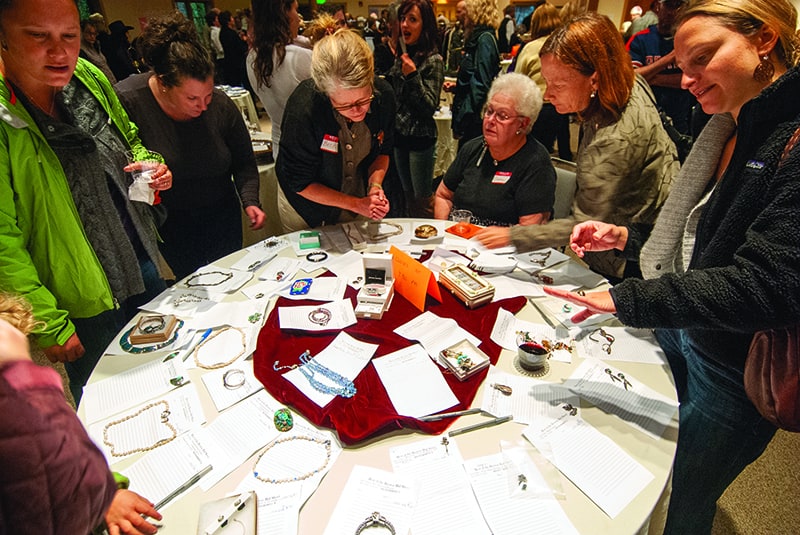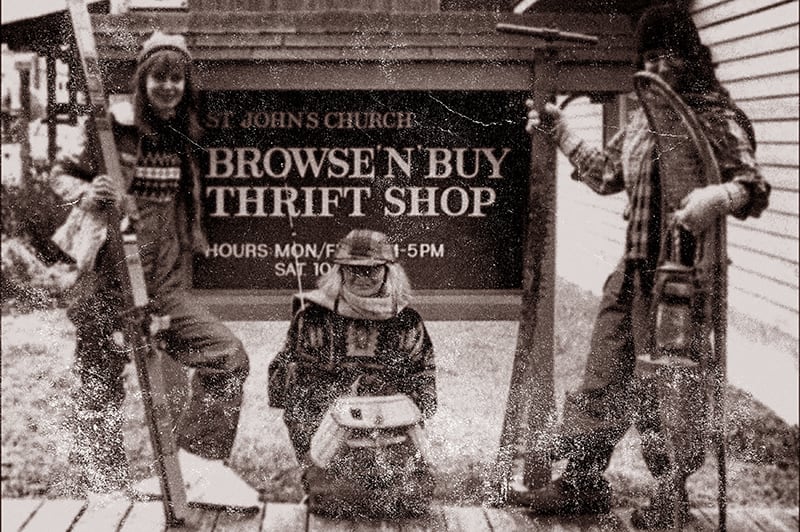Read The
Current Issue
A look back at the beginnings of Jackson Hole’s original thrift store on the event of its fiftieth anniversary, coming up in 2022.
By Whitney Royster
SOME OF MY best purchases include Patagonia jackets for my kids, soccer cleats, coolers, and frying pans. We’ve gotten puzzles and games, then donated them back again for other people to use. The best kid toys were from the lower shelves, including an adding machine (Sure! Punch every button!) and several plastic spatulas that were worth far more than their fifty-cent price tag for the several days of beatings they eventually took.
This is my love affair with Browse ‘N’ Buy.
Dubbed the “longest running garage sale in Teton County,” Browse ‘N’ Buy is the community center for good deals. An offshoot of St. John’s Episcopal Church, Browse ‘N’ Buy—or “the Browse,” or “Browser,”—sits a block north of the Town Square and is the county’s oldest secondhand store. Its customers include those on a budget, those who love a good treasure hunt, those looking for something offbeat like an ugly Christmas sweater or Halloween costume, those coming to town in summer shocked by both the cold temperatures and the retail cost of a jacket, and those who, like me, go to get deals for a great bragging session.
THE HISTORY OF Browse ‘N’ Buy is much as you’d expect. In the early 1970s, St. John’s church had a biannual rummage sale. People would donate items; volunteers from the church organized them and had a garage sale. Marge Hunt oversaw it. “I realized if we charged over a dollar, it wouldn’t sell,” Hunt, now ninety, says from her home in New Hampshire. She was polishing a set of donated sterling silver candlesticks (Remember when people had silver? And polished it?), and she told the priest at the time, Phil Zimmers, that they should save some of the best things and open up a little place and sell them at a more reasonable price. He liked the idea and brought Hunt to a meeting of church officials. He told the group, “People will come to browse and buy.”
“When I heard those words, I knew he had named the store,” Hunt remembers. Hunt also heard a rumor that another church was talking about opening a shop, so she advanced the opening date to November 4, 1972, for an “advantage,” she wrote in an essay about the store’s beginnings.
The shop’s first space was in the living room and kitchen of an apartment the church owned. There was a porch out front where people dropped off donations. Hunt cut a hole in the main door so people could pay for things that were left on the porch. After that, the store moved to a bigger space in the basement of an adjacent building, where people dropped their donations off via a slide. “One night a man went down the slide,” Hunt says. “I don’t know what he was looking for. He was in the shop when it opened.” Lou Breitenbach, who lived at the church and ran the Browse for nine years, says nothing was ever locked, so a man going down the slide doesn’t surprise her. Hunt cleaned out a coal room in this basement herself in order to hang Halloween costumes for rent. She rented out her husband’s opera hat, took a $10 deposit for it, and never saw it again.
For some time, the store had a reading nook where staff often found people asleep. Transient people would come in and get connected with jobs or places to live. People established friendships after seeing each other in the shop a few times. A woman dropped off a fur coat sent to her by her mother. “The daughter wanted nothing to do with the coat,” Hunt says. “But the mother called and said, ‘Well, did you get the diamond I put in the pocket?’ The coat had already sold.” Hunt put an ad in the paper looking for the person that bought it but had no replies.
By 1981 the store moved upstairs to Parish Hall, a space even larger than the basement, and in 1987, the current building on the south side of the St. John’s campus was built.
In a history of St. John’s church, Franklin Johnson, the rector there for nineteen years starting in 1981, quoted a church newsletter coming out on the tenth anniversary of Browse ‘N’ Buy, saying a shopper put down his jean jacket to try on some clothes. Someone picked up his jacket and bought it for twenty-five cents. When the man found out his jacket was sold, he ran down the street and caught up to the new owner. The new owner sold the jacket back to him for forty cents.
DONATIONS TO BROWSE ‘N’ Buy pour in from people moving, cleaning out their homes, and not wanting to throw out things that can be reused. Browse ‘N’ Buy’s current manager, Lonnie Brown, says the store gets donations of Thomas Mangelsen photographs and sculptures worth thousands of dollars. Once he got a donation that included a loaded handgun. (An accident, probably.) He gets so many donations of bullets that he keeps a collection by his desk and gives them to the police department about once a month. Brown also remembers a couple donating a car. “The people were leaving town, and the guy said, ‘I’ve got a car with a clean title,’ ” he says. Lonnie took it, reached out to organizations like the Community Safety Network and Climb Wyoming, and took applications to give the car away. He gave it to a woman with two children who took the bus every day from Alpine to Jackson.
The charity aspect is the fulcrum of Browse ‘N’ Buy’s business. The first year the Browser opened, the church earned $3,725 from sales. Ten years later, in 1982, sales were $20,500, or 21 percent of the church’s budget. By 1991, sales increased to $130,000, and by 1997 reached $225,000. In 2007, the gross sales were nearly $300,000. Today, Browser’s gross revenue is close to $1 million and proceeds are about half that. The church uses this money for community outreach. It has sponsored programs like the Jackson (Food) Cupboard, Alcoholics Anonymous, and One22, which provides assistance, services, and information to people in need. (These organizations are also on the campus of St. John’s.) Browser’s proceeds also support the Good Samaritan Mission and the Hirschfield Center for Children and were used to buy uniforms for the Jackson Hole High School cross-country team.
The shop does about 275 transactions on a typical summer day, with an average sale of $17, according to St. John’s communications director Haley Deming. That compares with 2016 averages of 175 daily transactions of an average of $12.48. Since 2005, Browse ‘N’ Buy’s growth has been about 120 percent, but it wasn’t until 2016 that Brown implemented a business plan for the operation. Part of this plan is a limit on prices. For example, a new-with-tags Patagonia jacket will never cost more than $38. Prices go down from there depending on condition and brand. Brown says anything Patagonia or Stio flies off the racks.
Any item that gets donated has five potential destinations: the shop floor for sale, Big Brothers/Big Sisters, Savers (a chain of thrift stores), the recycling center, or trash. (The amount of trash the shop generated in textiles is a mere 2 percent of its donations.) While employees plead with people to limit donations to things they would buy, donors can be assured that their wares will be reused to the best of the store’s ability. It’s the ultimate recycling center. Last year alone, Browser recycled 134 tons of textiles.
Hunt delights in the legacy Browse ‘N’ Buy has created. She was happy to be a church volunteer, running the shop in its early years while her children played under the coat racks. She remembers selling blue jeans for fifty cents and cleaning a child’s jacket herself in her tub, changing the water every day for over a week until she could put it out for sale. “I still find it hard to believe that this last year they took in nearly $1 million,” she says. JH

Ashley Wilkerson







